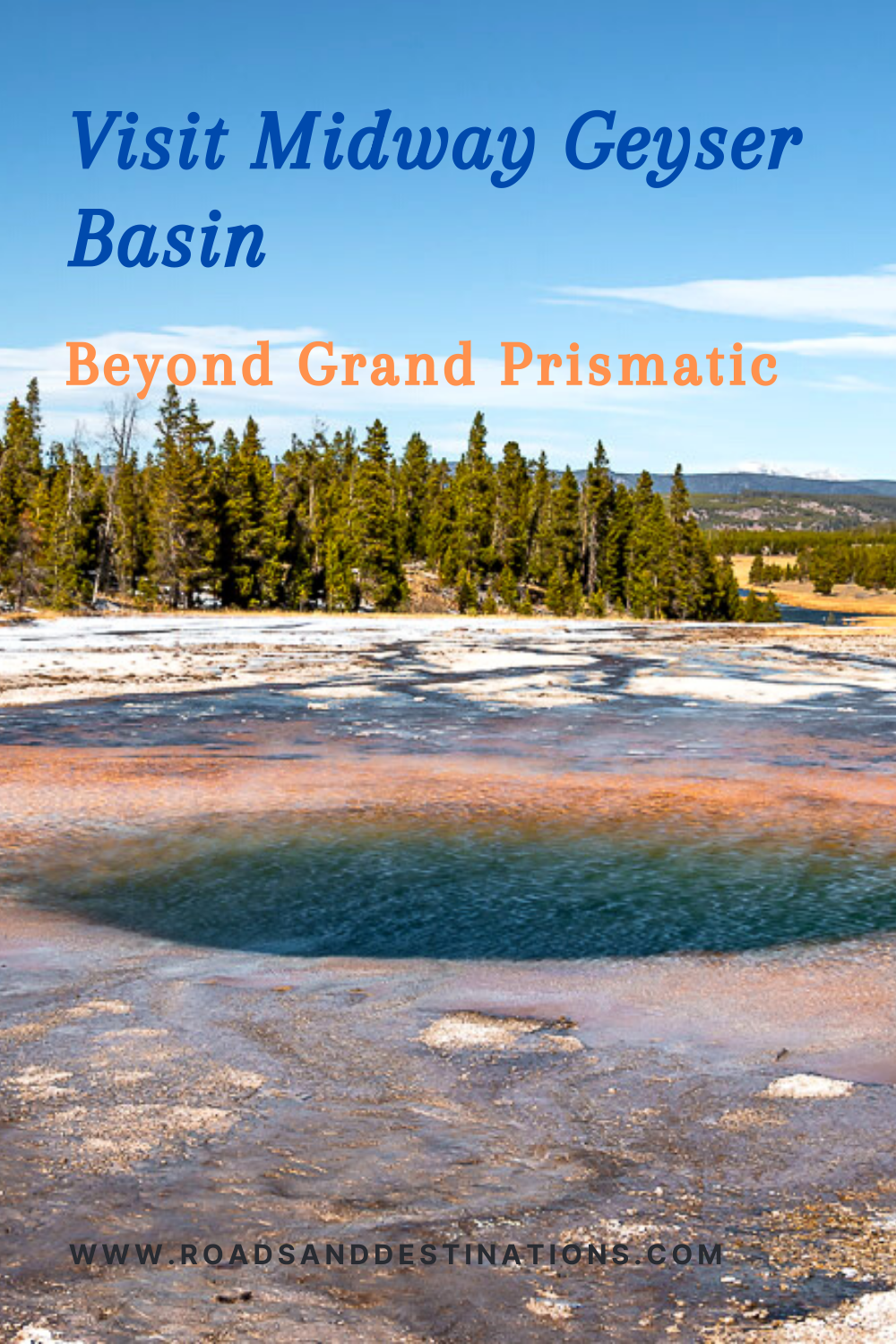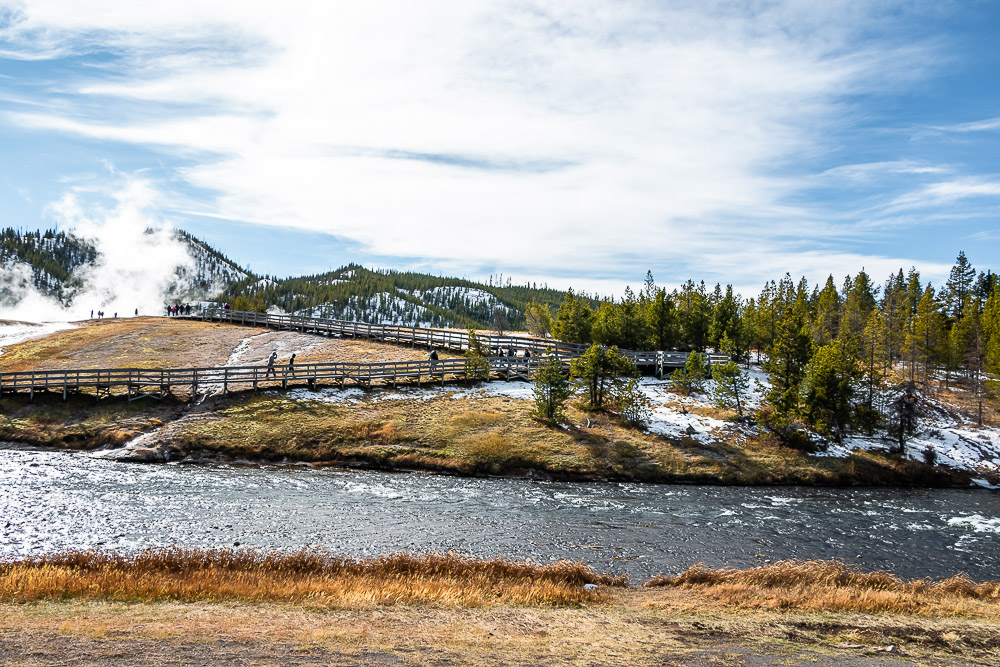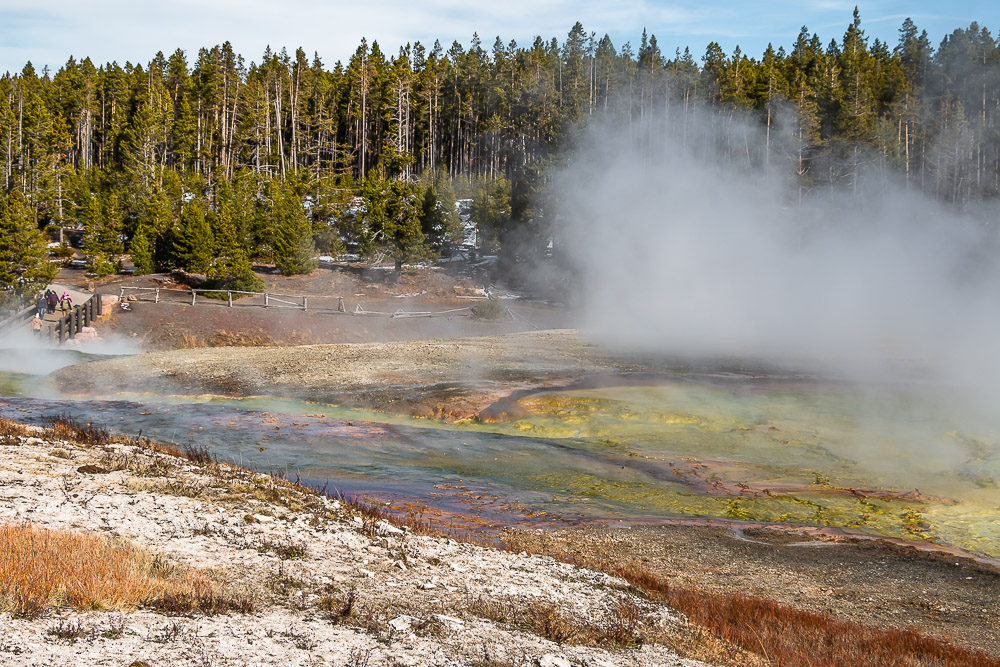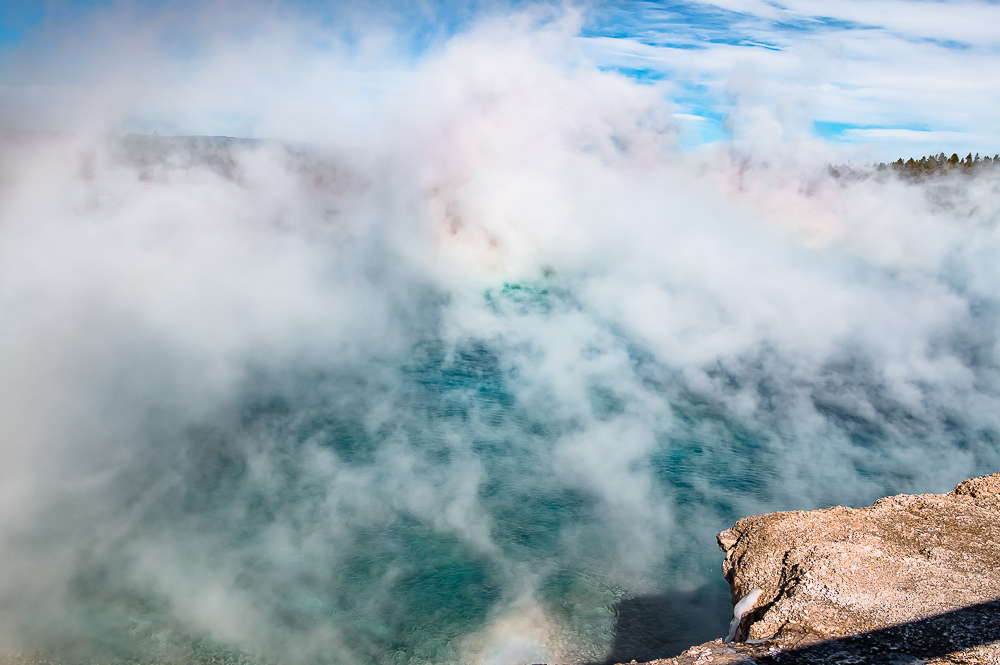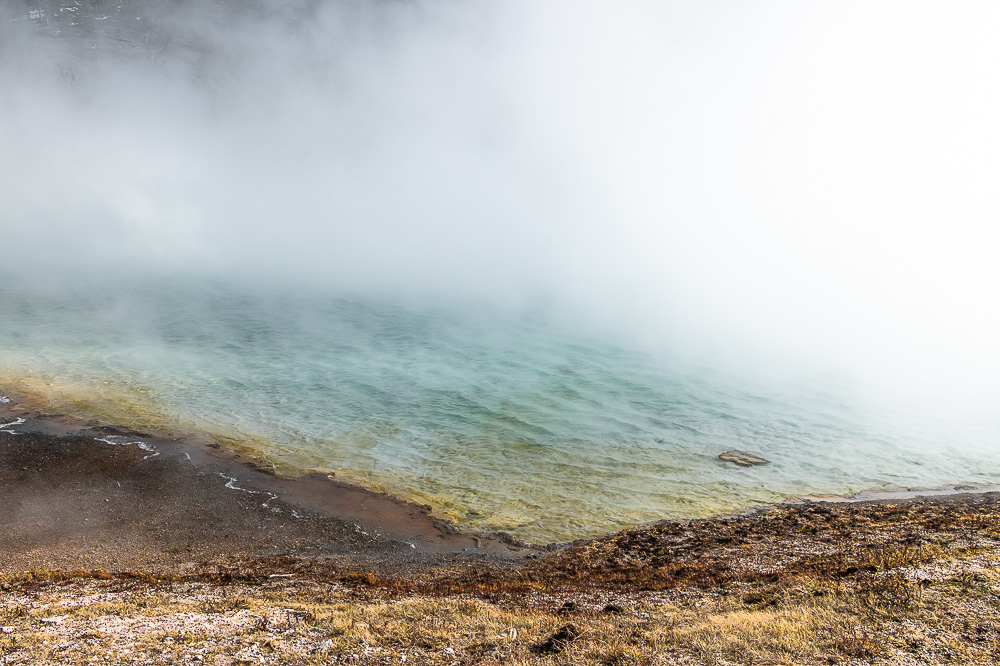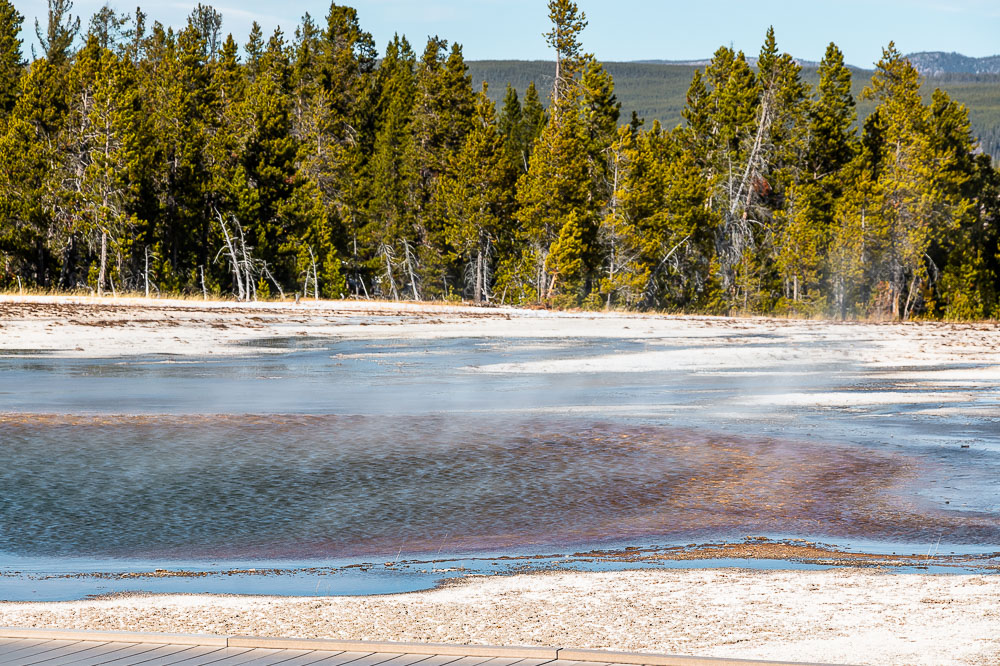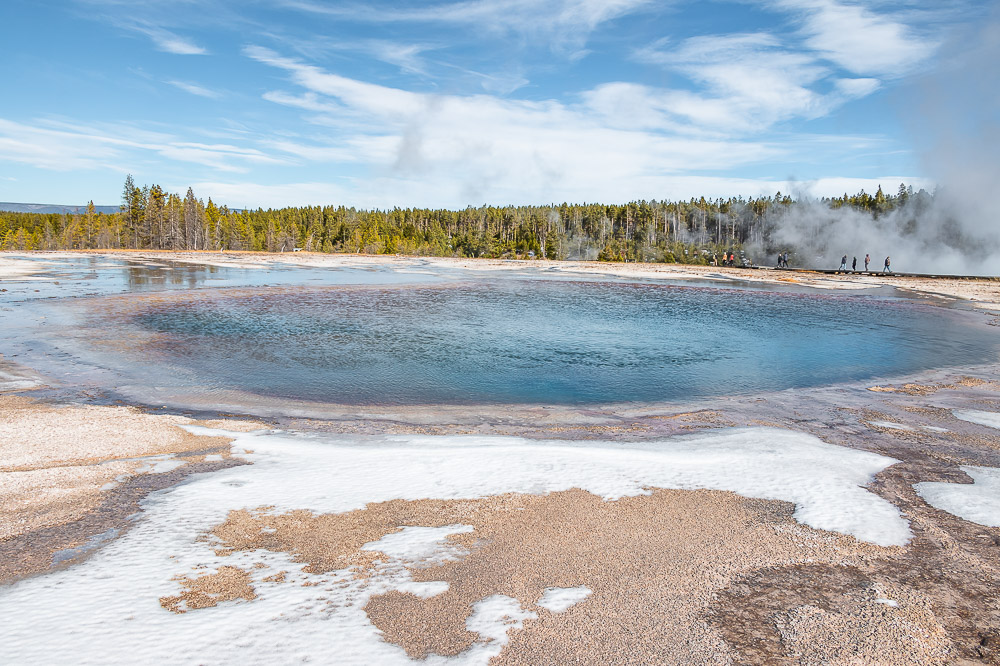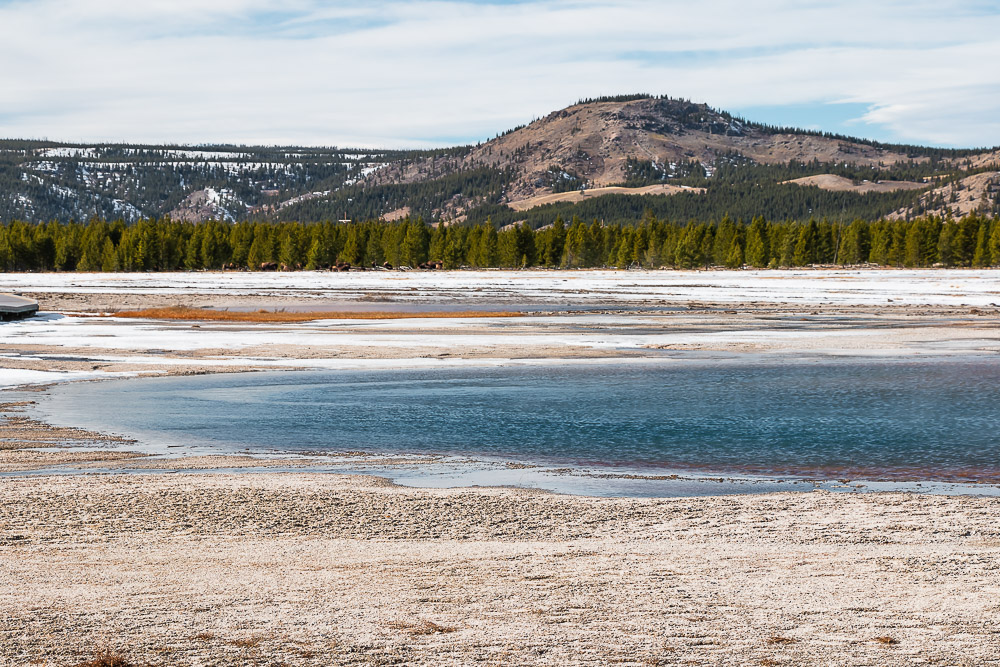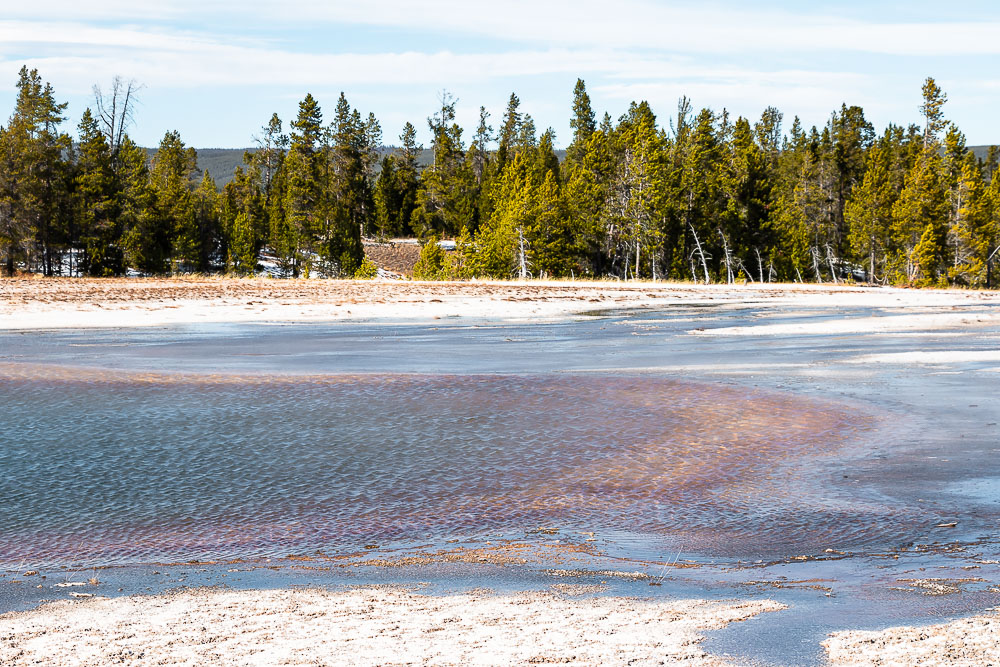One of the smallest geyser basins in Yellowstone National Park… Home to just a few big hydrothermal features… A place that hardly accommodates winter visitors… It seems that the Midway Geyser Basin is not worth a visit. Yet, despite all these shortcomings, the area belongs to the highlights of Yellowstone National Park. Protecting some of the most remarkable geysers and hot pools, the Midway Geyser Basin entices millions of people that visit the park every year.
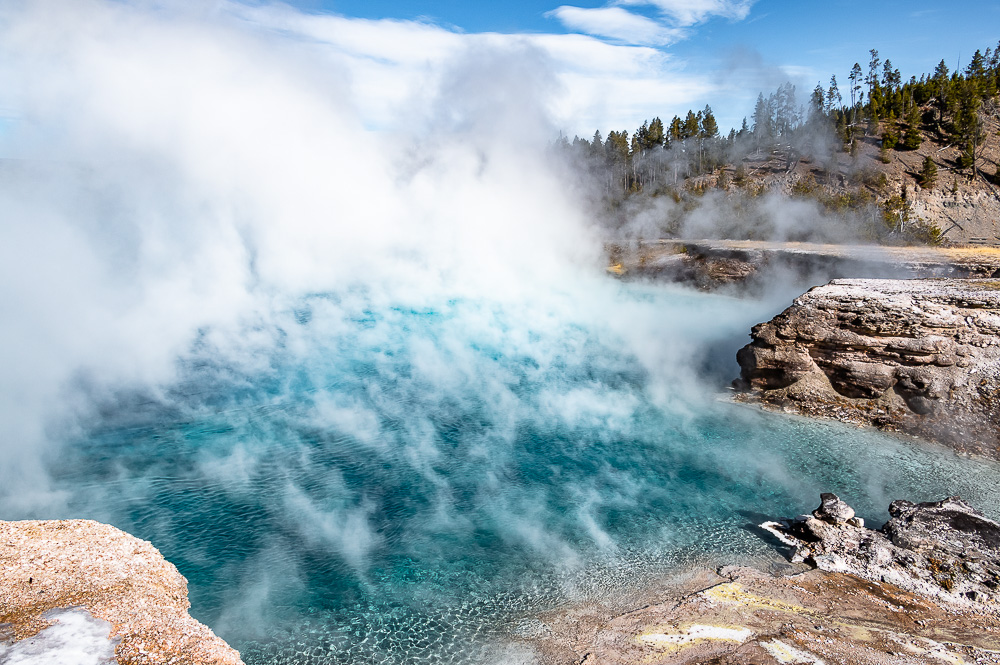
Visit Midway Geyser Basin: Introduction
The Midway Geyser Basin is one of the smallest among the main geyser basins in Yellowstone National Park. Set in the southwest of the park, it boasts only four hydrothermal features that are big enough to raise any interest. Nevertheless, a visit to the Midway Geyser Basin tops all Yellowstone’s adventures.
Nature lovers from all over the world flock to the area to see its prime attraction, the Grand Prismatic Spring. This largest hot spring in the USA allures with its astounding bright colors near the rim and deep blue shades at the center. For most travelers, it’s the only reason to visit the Midway Geyser Basin.
This, however, doesn’t imply that the other hydrothermal features in the basin are inferior. Indeed, they are smaller and, for the most part, lack the vibrant coloration of the Grand Prismatic Spring. But the real reason why fewer people include these hydrothermal features in their trips is because the majority of Yellowstone guides hardly ever mention them .
In this guide to the Midway Geyser Basin, we list all the major hot pools and geysers you should visit in the area. You will learn some interesting facts as well as what to expect to see in this part of Yellowstone. This guide will help you plan your visit to the Midway Geyser Basin and answer the most popular questions. How much time do you need to visit the Midway Geyser Basin? It the Midway Geyser Basin worth a visit? How long is the basin’s boardwalk? Read on to learn more and plan your visit to the Midway Geyser Basin.
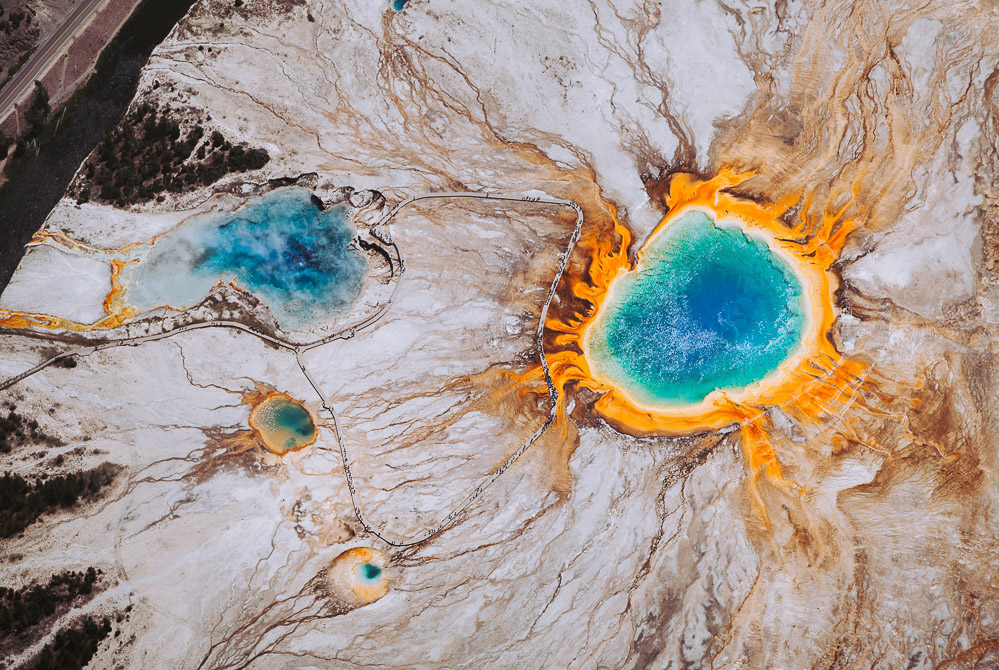
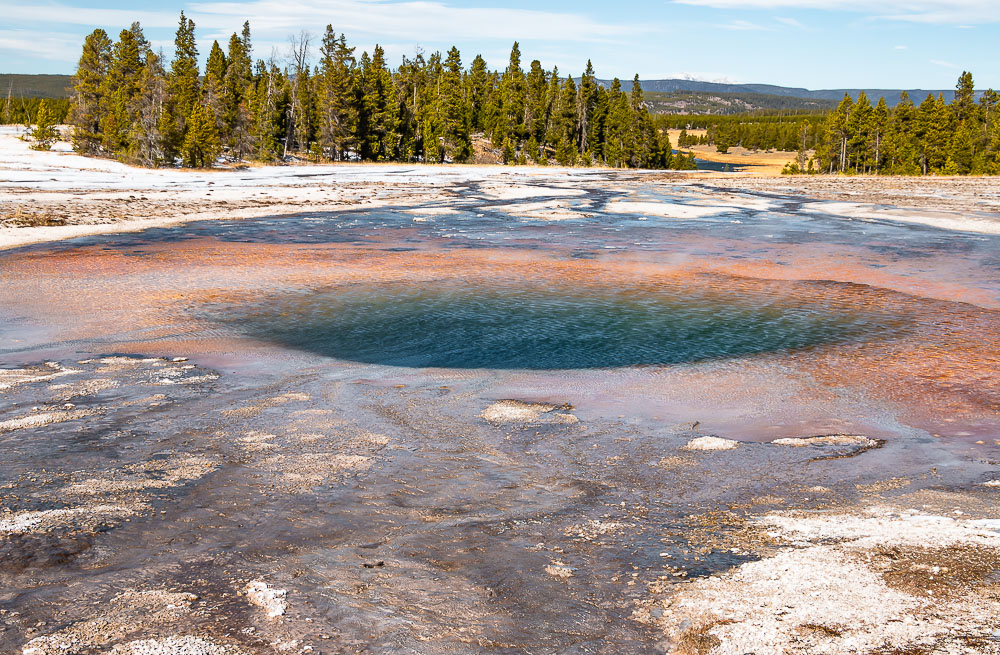
Reasons to Visit Midway Geyser Basin
The primary reason to visit the Midway Geyser Basin is, as we stated earlier, its stunning Grand Prismatic Spring. The world-famous natural wonder is the largest resident of the basin that welcomes nearly four million travelers a year. It wouldn’t be an overstatement to say that the colorful hot spring is one of the crown jewels of Yellowstone National Park itself. In fact, for many people, this remarkable natural phenomenon is the main reason to visit this remote park in Wyoming in the first place.
However, the other hydrothermal features in the Midway Geyser Basin are also worth a visit. They might not hit the headlines (at least not now). Nevertheless, these geysers and hot springs never cease to impress with their colors, shapes, natural surroundings, and quite remarkable history.
It’s really a shame that most people who visit the Midway Geyser Basin don’t know about the existence of these hydrothermal features until they meet them. Undoubtably, none of these “dwellers” can compete with the remarkable Grand Prismatic Spring. Yet, their uniqueness and unprecedented natural beauty surprise the oblivious visitors again and again.
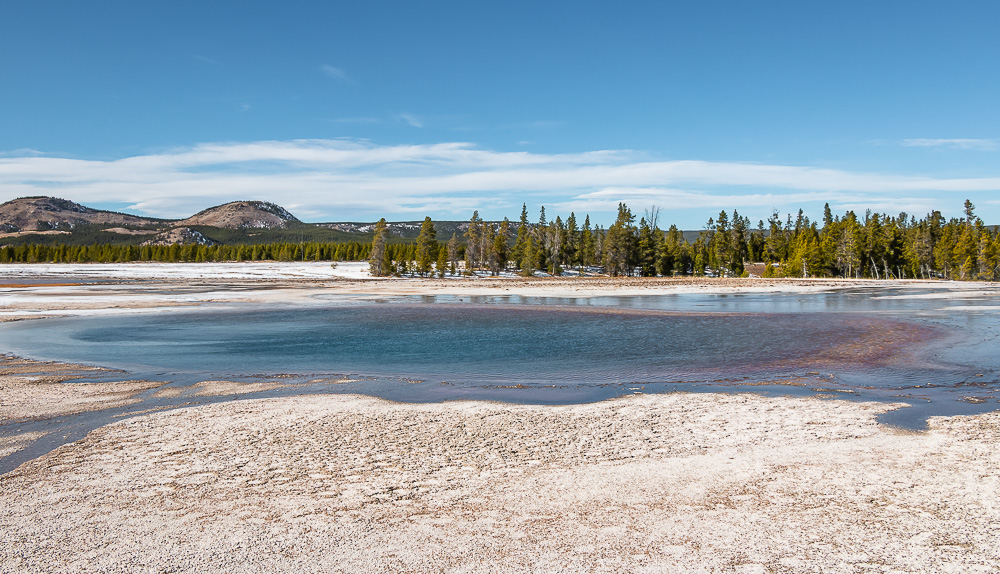
Location and how to Visit Midway Geyser Basin
The Midway Geyser Basin sits in the southwestern part of Yellowstone National Park, 11 miles south of Madison Junction on the Grand Loop Road (Route 89).
Many travelers, however, visit the Midway Geyser Basin after attending memorable “shows” performed by Old Faithful. In this case, drive 6 miles north via the Grand Loop Road and turn left into the Midway Geyser Basin parking area. Some of the Yellowstone’s guests also visit charming and less popular Biscuit Basin, located between the Old Faithful area and the Midway Geyser Basin, along the way.
The parking lot is clearly marked, eliminating any possibilities for you to get lost. It’s a big lot with plenty of parking spots. In summer, however, it fills up quickly. Thus, visit the Midway Geyser Basin early in the morning or late in the evening to ensure that you get an open spot upon your arrival. From there, walk toward the Firehole River where a boardwalk to the biggest hydrothermal features in the basin begins.
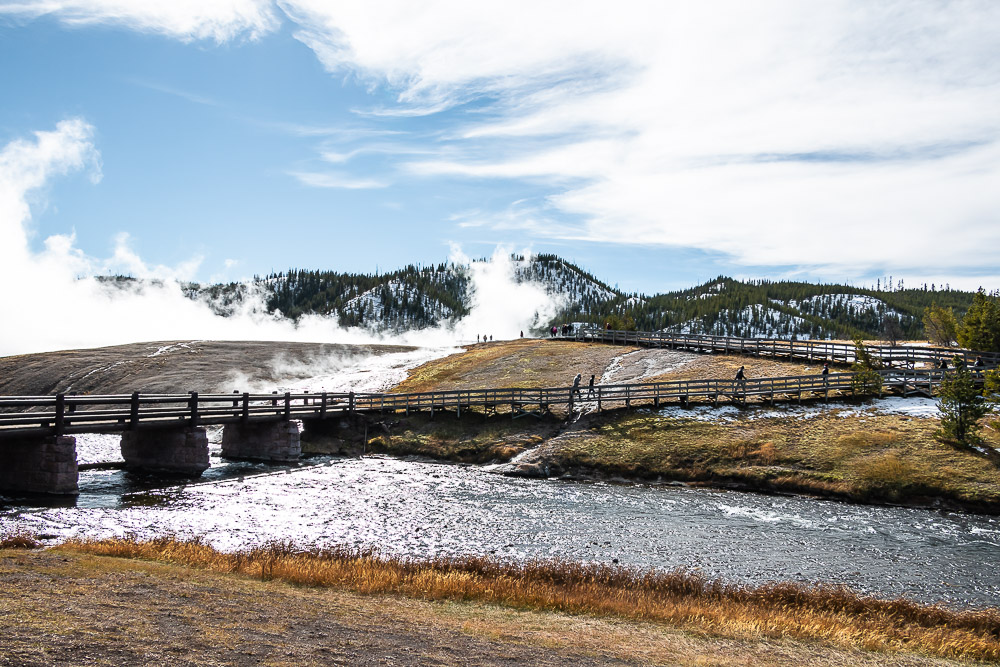
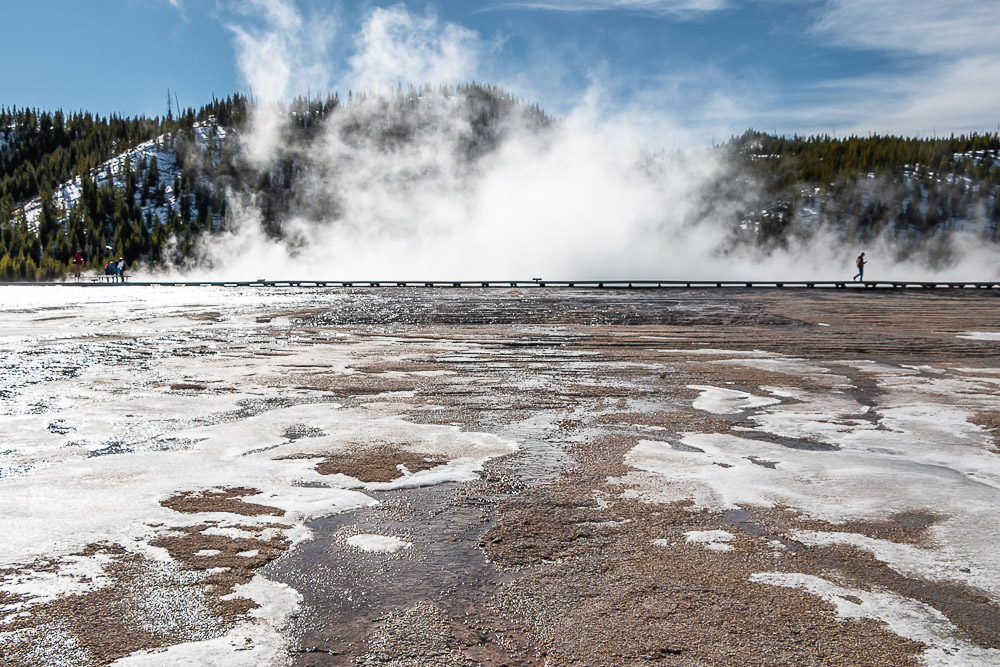
Midway Geyser Basin Boardwalk
The 0.8-mile boardwalk runs across the Firehole River and snakes around the Midway Geyser Basin, gaining in elevation only 75 feet. Less than a quarter mile from the start, the wooden path splits. A sign near the fork indicates that you must proceed to the left, loop the basin, and return to the junction from the right. Following the loop, you get as closely as the boardwalk only allows to four hydrothermal features of the Midway Geyser Basin: Excelsior Geyser, Grand Prismatic Spring, Opal Pool, and Turquoise Pool.
How Much Time do You Need to Visit Midway Geyser Basin Boardwalk?
The boardwalk is short and flat. No challenges or elevation gains await once you get to the split near Excelsior Geyser. The entire hike takes approximately 15 minutes. However, plan for a longer visit as people often spend more time enjoying the vibrant colors and photographing the hydrothermal features of the Midway Geyser Basin than walking on the boardwalk. On average, the visitors spend anywhere from 45 minutes to 1 hours here.
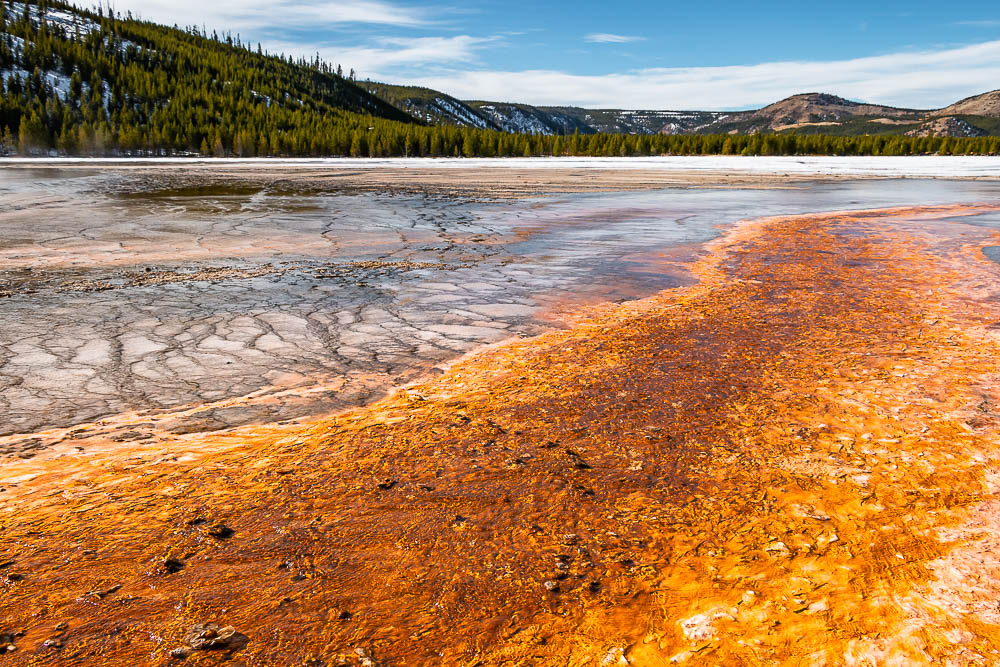
Visit Midway Geyser Basin: What to See
Grand Prismatic Spring
The Grand Prismatic Spring is the star and the main reason to visit the Midway Geyser Basin. The largest hot spring in the USA and the third largest in the world, it entices with its colorful vibrance and not less impressive size. Although you can see only a small part of the Grand Prismatic Spring from the boardwalk, the site never ceases to astound you.
Interestingly enough, the rainbow colors of the Grand Prismatic Spring change their shades throughout the year. What looks like that brightest orange hues you’ve even encountered in nature, fades and acquires green shades a few months later.
We prepared a detailed guide to the Grand Prismatic Spring that reveals all the secrets behind its rainbow brilliance. You will find information about the best time to visit the Grand Prismatic Spring and the Midway Geyser Basin. This travel guide also contains some interesting facts as well as useful tips how to photograph the world-famous hot spring.
LEARN MORE: Visit Grand Prismatic Spring (The Ultimate Guide)
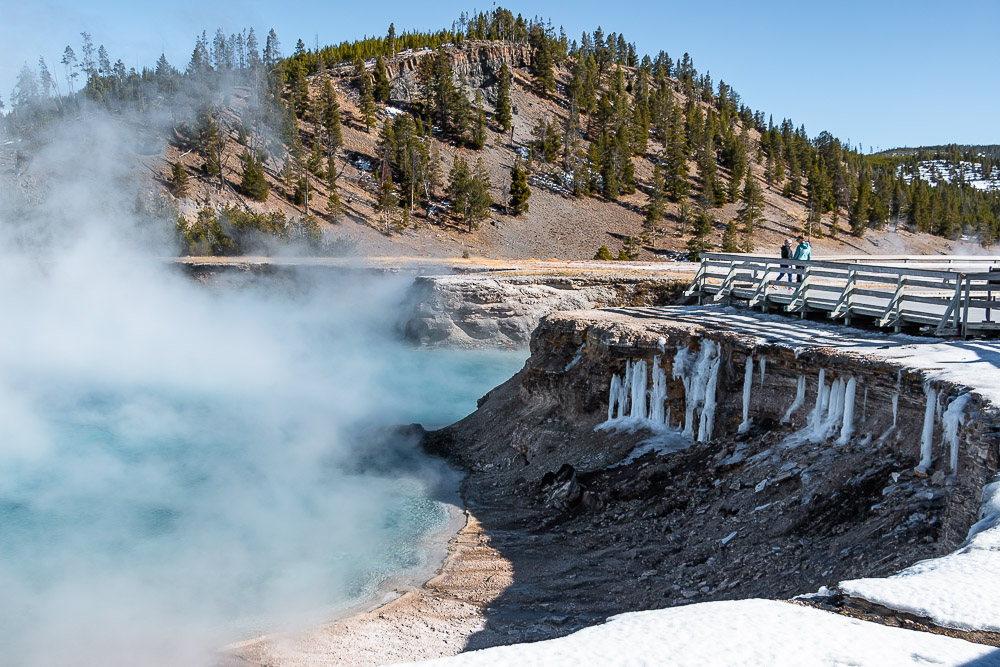
Visit Excelsior Geyser Crater in the Midway Geyser Basin
The first hydrothermal feature you meet during your visit to the Midway Geyser Basin is Excelsior Geyser Crater. Once an active geyser, it’s a dormant fountain-type geyser today. The average temperature of this giant lingers at 199 degrees Fahrenheit.
Similar to its closest neighbor, the Grand Prismatic Spring, Excelsior Geyser overwhelms with its size. The largest geyser in the area is more than 276 feet wide and 328 feet long. However, despite these impressive proportions, you need to be lucky to gauge the full size of the geyser.
This time, though, heavy steam, not the size – like it’s the case with the Grand Prismatic Spring – prevents you from accomplishing this mission. The dormant hydrothermal feature in the Midway Geyser Basin releases the haze thick enough to barely see anything within a few feet in front of you. You can experience this dry, hot “sauna” anytime of the year. Colder weather, however, always makes sure to shower you with extra steam as soon as you step on the narrow boardwalk in the Midway Geyser Basin.
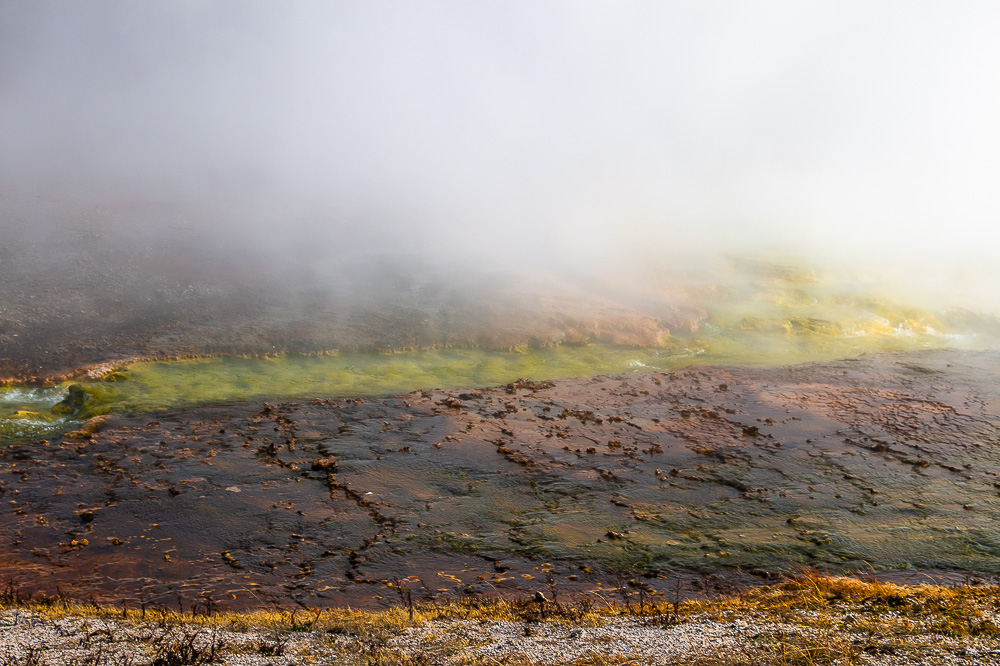
Excelsior Geyser in Its Heyday
Mostly sleeping nowadays, Excelsior Geyser was once the largest active geyser in the world. Between 1878 and 1890, it shot boiling water up to 300 feet into the air, 300 feet wide. According to John Muir, the eruptions of the most popular feature in the Midway Geyser Basin at that time averaged from 50 to 300 feet in height in 1898. The eruptions, however, were irregular and soon ceased almost completely. Excelsior shook the ground in the Midway Geyser Basin again in 1891 and 1901. Nevertheless, these eruptions were no match to the former glory of the geyser.
Finally in 1985, Excelsior Geyser resumed its activity, greatly puzzling Yellowstone’s rangers and visitors of the Midway Geyser Basin. The eruptions continued for 46 hours, between September 14 and 16. Some of them reached heights of 75 feet. Simultaneously, the splashes of boiling water extended to 75 feet wide.
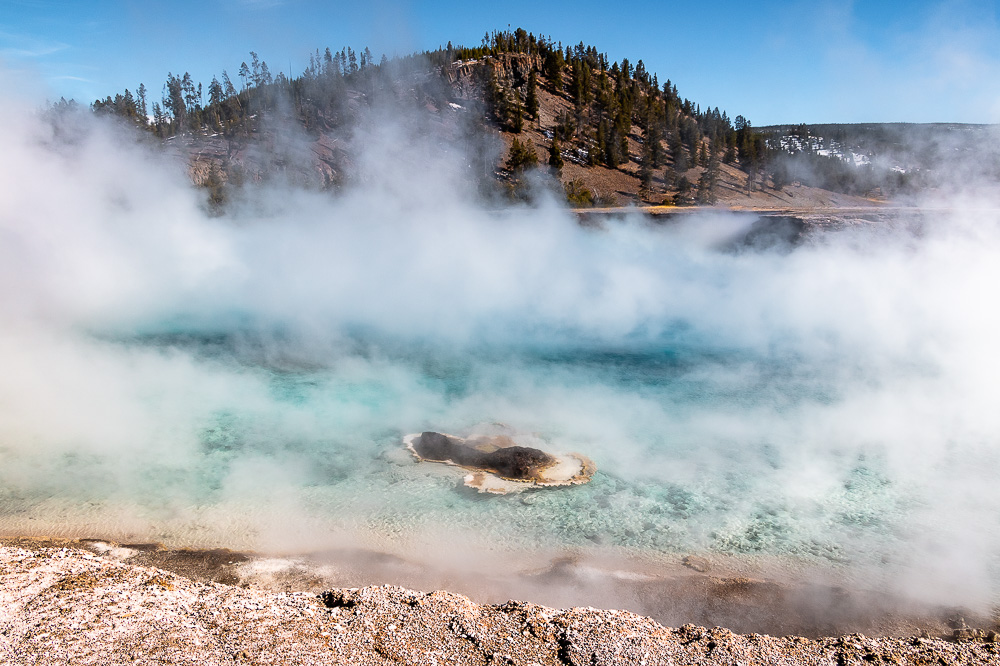
Excelsior Crater Today
No activity was registered at the geyser afterward. However, due to ever-changing environment and ever-breathing area underneath the thin layer of Yellowstone’s ground, Excelsior can wake up once again. If it happens, the geyser might even surpass the popularity of the Grand Prismatic Spring and become the main reason to visit the Midway Geyser Basin.
As for now, the crater produces almost 45 gallons of runoff per minute. You can see the colorful streams flowing into the Firehole River as you cross the bridge on your way to the Midway Geyser Basin. The runoff amounts to 6 million gallons a day, which is a little bit more than 9 Olympic swimming pools of water per day. Can you even disregard this sleeping giant during your visit to the Grand Prismatic Spring in the Midway Geyser Basin after that?
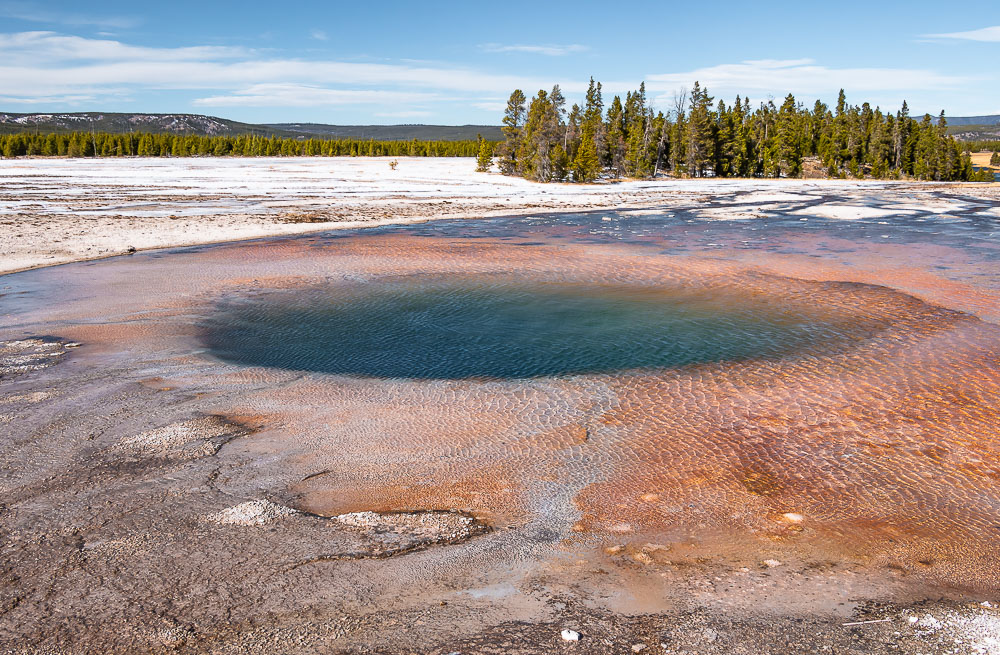
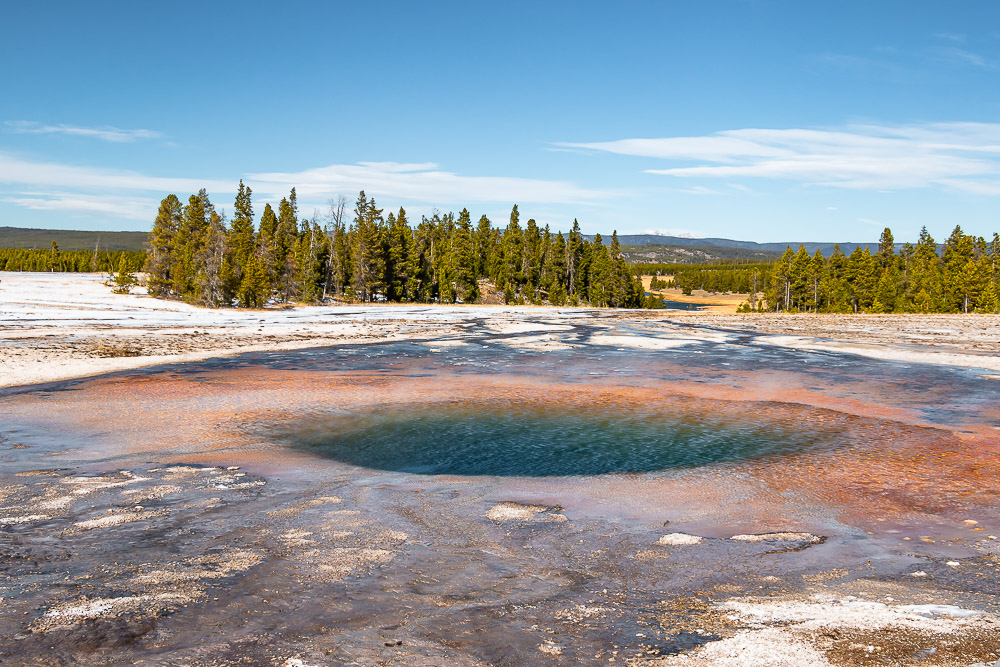
Opal Pool
As you walk past Excelsior and the Grand Prismatic Spring, Opal Pool greets you on the other side of the most popular attraction in the area. And once again, it enhances your visit to the Midway Geyser Basin with a pop of color and breathtaking views.
Opal Pool is a hot spring that is also considered a fountain-type geyser. Hot as any other hydrothermal residents of the Midway Geyser Basin, it keeps its temperature at approximately 132 degrees Fahrenheit. If you stay long enough (which can extend you visit to the Midway Geyser Basin for about a year; obviously, no one will do it.), you can see the largest active geyser in the area performing its “miracles”.
Opal Pool’s Eruptions
The recorded history of the pool dates back to 1947 when a few eruptions where observed. The activity of the Grand Prismatic Spring’s neighbor resumed in 1949, 1952, and 1953 only to cease until 1979. The eruptions has occurred at least once a year since late 1980s.
Opal Pool has never reached the glory of the other hydrothermal features in the Midway Geyser Basin, especially the Grand Prismatic Spring. Much smaller in size, it releasing a column of boiling water that reaches heights of up to 30 feet. Extremes, however, happen. On those rare occasions, the water can be ejected up to 70-80 feet into the air.
In 2005, Opal Pool drained completely. Yet, three year later, it resurfaced as a vivid green pool.
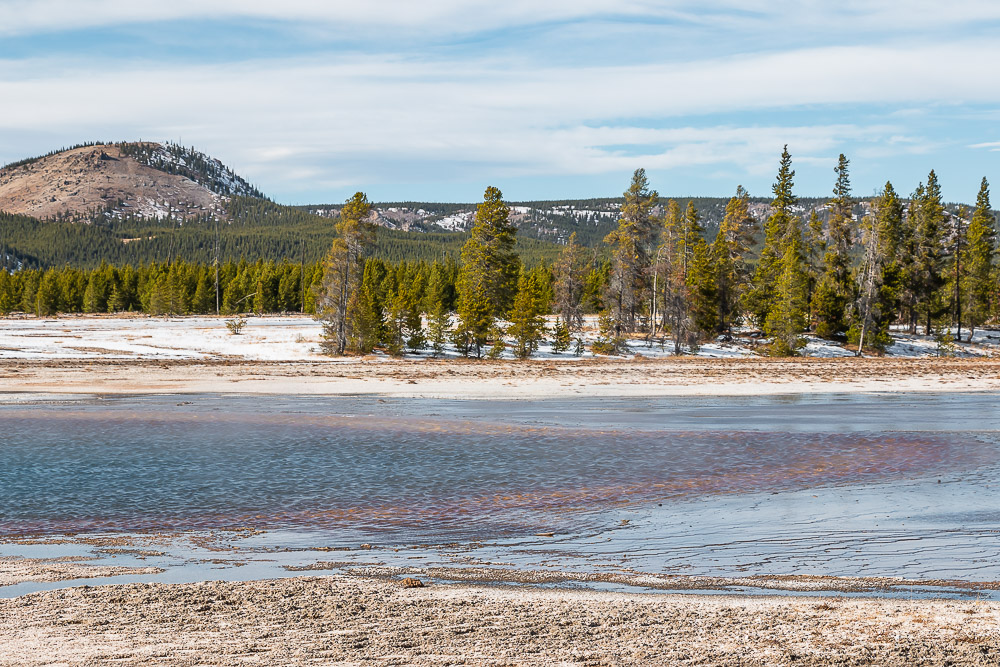
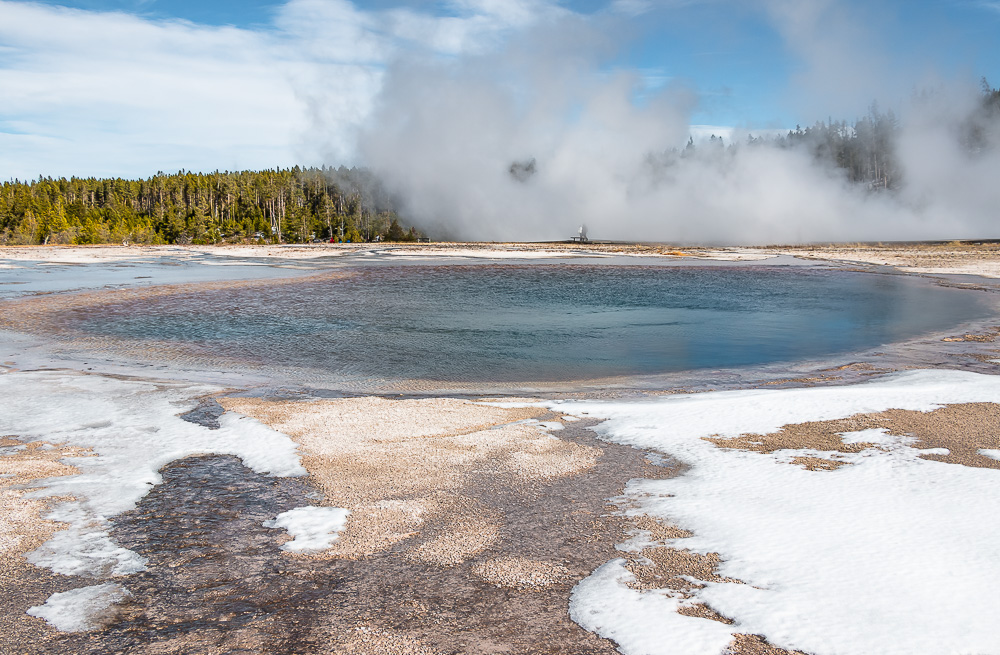
Turquoise Pool
Turquoise Pool is the last large hydrothermal feature to visit in the Midway Geyser Basin. Sitting to the right from Opal Pool, it marks the end of your short, but memorable boardwalk adventure. One of the smallest hydrothermal features you can see during your visit to the Midway Geyser Basin (100×110 feet), Turquoise Pool raises its temperature to 142-160 degrees Fahrenheit.
Similar to the Grand Prismatic Spring, this natural wonder owes its name to the Hayden Expedition. In 1878, the early park’s explorers named the feature Turquoise Pool for its milk white bottom and blue water.
To see more than just the bright coloration of Turquoise Pool, visit the Midway Geyser Basin in June and July. During these months, purple fringed gentians adorns the area. The flowers are especially fond of the barren ground surrounding Turquoise Pool.
Unlike Excelsior Geyser, the hot pool doesn’t have apparent overflow channel. Instead, the water drains through seepage. Both of these hydrothermal features, however, are connected through several underground channels. In the heydays of Excelsior Geyser, Turquoise Pool lowered almost ten feet. It took nearly a year for the smaller member of the Midway Geyser Basin to recover after the impressive actions of its bigger “sibling”.
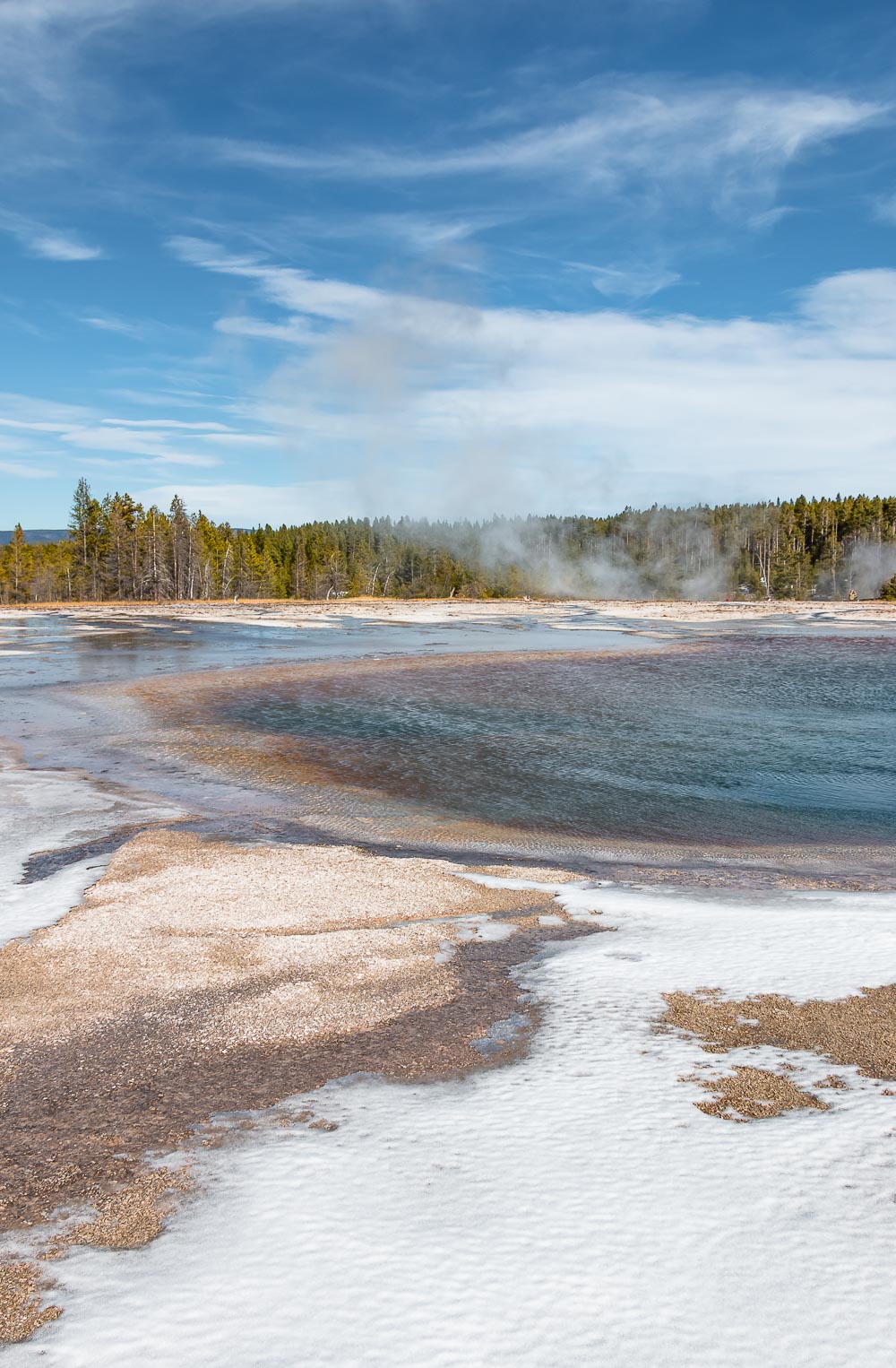
Protecting Fragile Environment
Whether you visit the Midway Geyser Basin to gaze at the Grand Prismatic Spring or admire its lesser-known natural wonders, be sure to always stay on the boardwalk.
In June 2020, two Philadelphia women disregarded Yellowstone’s regulations and walked on the colorful bacterial mat surrounding Opal Pool. These silly actions had some serious consequences. First, such negligent behavior could negatively impact Opal Pool and kill its precious heat-loving microorganisms. This, in its turn, could interfere with the vibrant coloration of the Midway Geyser Basin.
Second, each of these women paid the fee of $457 and spent two nights in jail. Additionally, they had to postpone their next visit to the Midway Geyser Basin and Yellowstone for two years.
Holding on to your hats and caps also helps protect the fragile environment. Under windy conditions, these items can fly into the Midway Geyser Basin, polluting its hydrothermal features and killing the bacteria.
And certainly, no throwing coins in the hot pools. This superstition won’t bring luck to their executors, but can eventually destroy the basin.
No foreign items, intentionally or unintentionally dropped into the springs and geysers, must enter the thermal water. For that reason, flying drones is not allowed in the Midway Geyser Basin. Please follow the park’s regulations to preserve the fragile environment for many others to see it in person rather than just in pictures.
Entrance Fees to Midway Geyser Basin
Permit to the Midway Geyser Basin is included in Yellowstone National Park entrance fee. A 7-day Yellowstone pass costs $35. Annual passes ($70) allow you to visit the Midway Geyser Basin anytime throughout the year. America the Beautiful pass ($80) let you experience Yellowstone National Park along with all other national parks in the USA within a year of purchase.
Final Thoughts
This concludes our guide to the remarkable hydrothermal features to visit in the Midway Geyser Basin. While the Grand Prismatic Spring might be the star of the area, the other geysers and hot springs are as spectacular as the most recognizable of them. There is really no excuses to dismiss the lesser-known natural wonders and focus only on the popular spring. We hope, this guide sets the record straight and inspires you to visit the basin and see everything it has to offer.
TIP: If you’re looking for more travel tips and information about Yellowstone National Park, please check out these guides.
- 10 Things You Must See on Your First Visit to Yellowstone
- Visit Upper Geyser Basin in Yellowstone: Guide, Features, Tips, and Map
- Visit Old Faithful in Yellowstone (Complete Guide)
- Where to Find the Best Historic Buildings in the American West
If you found this post useful, don’t forget to pin it for later and share it with your friends.
